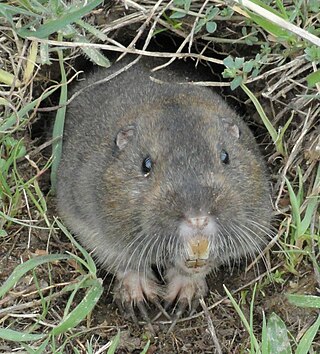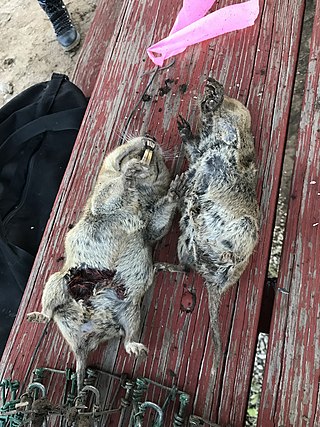
Heteromyidae is a family of rodents consisting of kangaroo rats, kangaroo mice, pocket mice and spiny pocket mice. Most heteromyids live in complex burrows within the deserts and grasslands of western North America, though species within the genus Heteromys are also found in forests and their range extends down as far as northern South America. They feed mostly on seeds and other plant parts, which they carry in their fur-lined cheek pouches to their burrows.

Pocket gophers, commonly referred to simply as gophers, are burrowing rodents of the family Geomyidae. The roughly 41 species are all endemic to North and Central America. They are commonly known for their extensive tunneling activities and their ability to destroy farms and gardens.

The smooth-toothed pocket gophers, genus Thomomys, are so called because they are among the only pocket gophers without grooves on their incisors. They are also called the western pocket gophers because they are distributed in western North America. They are considered distinct enough from other pocket gophers to be recognized as a separate subfamily or tribe.

The yellow-faced pocket gopher is a species of pocket gopher that is native to shortgrass prairies in the south-western United States and northern Mexico. It is the species that lives north of the Southern Coahuila Filter-Barrier (SCFB). Among the different species, the yellow-faced pocket gopher has a small to medium-sized skull. The fossil of this genus was recorded from the pre-Pleistocene Benson Beds of Arizona.

The desert pocket gopher is a species of rodent in the family Geomyidae. It is found in the state of Chihuahua in Mexico and in Texas and New Mexico in the United States.

Heteromys is a genus of rodents in the family Heteromyidae, commonly known as spiny pocket mice. It is the only extant genus in the subfamily Heteromyinae which also includes the extinct genera Diprionomys and Metaliomys. Heteromys was recently enlarged by inclusion of the members of formerly recognized heteromyine genus Liomys, which was found to be paraphyletic.
The Chiriqui pocket gopher is a species of rodent in the family Geomyidae. It is found in Costa Rica and Panama. Some authors classify it in the genus Orthogeomys, but recent research has allowed this and its related species to be classified in the genus Heterogeomys.
Heterogeomys is a genus of rodent in the family Geomyidae, found in Mexico, Central America and Colombia. Heterogeomys are a small genus of rodents commonly known as pocket gophers, though the term applies to all genera within the family Geomyidae. The name pocket gopher was earned for this family because of their fur lined cheek pouches that can be used for carrying food. These pouches can also be turned inside out. Species of Heterogeomys are regarded as pests, one of less than 5% of rodent species classified as pests, and the history of man's attempts to control their populations reaches back into Mayan times. Despite some efforts to the contrary, populations of Heterogeomys seem to be on a general upwards trend. Furthermore, all of the species of Heterogeomys are considered to be of Least Concern in the World Status Key.
Cherrie's pocket gopher is a species of rodent in the family Geomyidae. It is found in Honduras, Nicaragua, and Costa Rica. It is threatened by habitat loss. Some authors classify it in the genus Orthogeomys, but recent research has allowed this and its related species to be classified in the genus Heterogeomys.
The Darien pocket gopher is a species of rodent in the family Geomyidae. It is occurs in Panama and Colombia. Some authors classify it in the genus Orthogeomys, but recent research has allowed this and its related species to be classified in the genus Heterogeomys.
The variable pocket gopher is a species of rodent in the family Geomyidae. It is endemic to Costa Rica, usually being found in grasslands and tropical forests at higher altitudes, up to 8,000 feet. It is threatened by habitat loss, but are sometimes kept as pets in the United States and elsewhere.
The hispid pocket gopher is a species of rodent in the family Geomyidae. It is found in Mexico, Belize, Guatemala, and Honduras. Some authors classify it in the genus Orthogeomys, but recent research has allowed this and its related species to be classified in the genus Heterogeomys.
The big pocket gopher is a species of rodent in the family Geomyidae. It is endemic to Veracruz state in eastern Mexico. It has only been found on the southeastern slopes of Pico de Orizaba, at elevations of 1,300 metres (4,300 ft).
Underwood's pocket gopher is a species of rodent in the family Geomyidae. It is endemic to Costa Rica. Some authors classify it in the genus Orthogeomys, but recent research has allowed this and its related species to be classified in the genus Heterogeomys.
Buller's pocket gopher is a species of gopher that is endemic to Mexico. It is monotypic within the genus Pappogeomys.
The Michoacan pocket gopher is a species of rodent in the family Geomyidae. It is monotypic within the genus Zygogeomys. It is endemic to Mexico where its natural habitat is temperate, high-altitude forests. Its numbers are declining and it is listed by the IUCN as "endangered".

The Oriental Basin pocket gopher is a species of pocket gopher which is endemic to Mexico. It was first described in 1895 by Clinton Hart Merriam. It was considered to be a subspecies of Merriam's pocket gopher in the late 20th and early 21st century but has been reinstated as its own species. The IUCN Red List has evaluated it to be of least concern.
The Perote pocket gopher, or Cofre de Perote pocket gopher, is a species of pocket gopher in the family Geomyidae.







